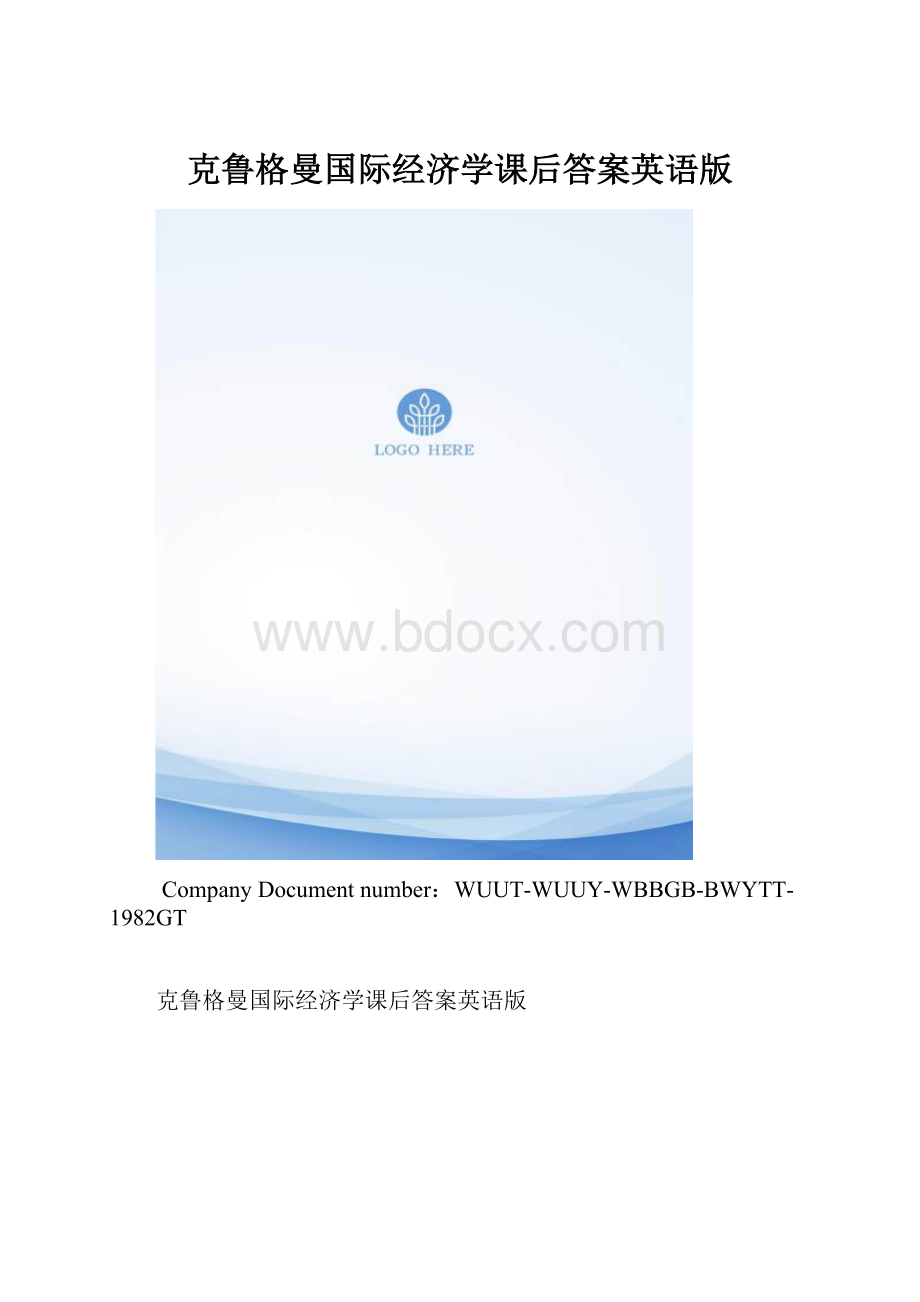 克鲁格曼国际经济学课后答案英语版.docx
克鲁格曼国际经济学课后答案英语版.docx
- 文档编号:27140633
- 上传时间:2023-06-27
- 格式:DOCX
- 页数:43
- 大小:52.18KB
克鲁格曼国际经济学课后答案英语版.docx
《克鲁格曼国际经济学课后答案英语版.docx》由会员分享,可在线阅读,更多相关《克鲁格曼国际经济学课后答案英语版.docx(43页珍藏版)》请在冰豆网上搜索。

克鲁格曼国际经济学课后答案英语版
CompanyDocumentnumber:
WUUT-WUUY-WBBGB-BWYTT-1982GT
克鲁格曼国际经济学课后答案英语版
CHAPTER2
LaborProductivityandComparativeAdvantage:
TheRicardianModel
AnswerstoTextbookProblems
1.a.Theproductionpossibilitycurveisastraightlinethatinterceptstheappleaxisat400(1200/3)andthebananaaxisat600(1200/2).
b.Theopportunitycostofapplesintermsofbananasis3/2.Ittakesthreeunitsoflabortoharvestanapplebutonlytwounitsoflabortoharvestabanana.Ifoneforegoesharvestinganapple,thisfreesupthreeunitsoflabor.These3unitsoflaborcouldthenbeusedtoharvestbananas.
c.Labormobilityensuresacommonwageineachsectorandcompetitionensuresthepriceofgoodsequalstheircostofproduction.Thus,therelativepriceequalstherelativecosts,whichequalsthewagetimestheunitlaborrequirementforapplesdividedbythewagetimestheunitlaborrequirementforbananas.Sincewagesareequalacrosssectors,thepriceratioequalstheratiooftheunitlaborrequirement,whichis3applesper2bananas.
2.a.Theproductionpossibilitycurveislinear,withtheinterceptontheappleaxisequalto160(800/5)andtheinterceptonthebananaaxisequalto800(800/1).
b.Theworldrelativesupplycurveisconstructedbydeterminingthesupplyofapplesrelativetothesupplyofbananasateachrelativeprice.Thelowestrelativepriceatwhichapplesareharvestedis3applesper2bananas.Therelativesupplycurveisflatatthisprice.Themaximumnumberofapplessuppliedatthepriceof3/2is400suppliedbyHomewhile,atthisprice,Foreignharvests800bananasandnoapples,givingamaximumrelativesupplyatthispriceof1/2.Thisrelativesupplyholdsforanypricebetween3/2and5.Atthepriceof5,bothcountrieswouldharvestapples.Therelativesupplycurveisagainflatat5.Thus,therelativesupplycurveisstepshaped,flatattheprice3/2fromtherelativesupplyof0to1/2,verticalattherelativequantity1/2risingfrom3/2to5,andthenflatagainfrom1/2toinfinity.
3.a.Therelativedemandcurveincludesthepoints(1/5,5),(1/2,2),(1,1),(2,1/2).
b.Theequilibriumrelativepriceofapplesisfoundattheintersectionoftherelativedemandandrelativesupplycurves.Thisisthepoint(1/2,2),wheretherelativedemandcurveintersectstheverticalsectionoftherelativesupplycurve.Thustheequilibriumrelativepriceis2.
c.Homeproducesonlyapples,Foreignproducesonlybananas,andeachcountrytradessomeofitsproductfortheproductoftheothercountry.
d.Intheabsenceoftrade,Homecouldgainthreebananasbyforegoingtwoapples,andForeigncouldgainbyoneappleforegoingfivebananas.Tradeallowseachcountrytotradetwobananasforoneapple.HomecouldthengainfourbananasbyforegoingtwoappleswhileForeigncouldgainoneapplebyforegoingonlytwobananas.Eachcountryisbetteroffwithtrade.
4.TheincreaseinthenumberofworkersatHomeshiftsouttherelativesupplyschedulesuchthatthecornerpointsareat(1,3/2)and(1,5)insteadof(1/2,3/2)and(1/2,5).Theintersectionoftherelativedemandandrelativesupplycurvesisnowinthelowerhorizontalsection,atthepoint(2/3,3/2).Inthiscase,ForeignstillgainsfromtradebuttheopportunitycostofbananasintermsofapplesforHomeisthesamewhetherornotthereistrade,soHomeneithergainsnorlosesfromtrade.
5.Thisanswerisidenticaltothatin3.Theamountof"effectivelabor"hasnotchangedsincethedoublingofthelaborforceisaccompaniedbyahalvingoftheproductivityoflabor.
6.Thisstatementisjustanexampleofthepauperlaborargumentdiscussedinthechapter.Thepointisthatrelativewageratesdonotcomeoutofthinair;theyaredeterminedbycomparativeproductivityandtherelativedemandforgoods.Theboxinthechapterprovidesdatawhichshowsthestrongconnectionbetweenwagesandproductivity.Korea'slowwagepresumablyreflectsthefactthatKoreaislessproductivethantheUnitedStatesinmostindustries.Asthetestexampleillustrated,ahighlyproductivecountrythattradeswithalessproductive,low-wagecountrywillraise,notlower,itsstandardofliving.
7.Theproblemwiththisargumentisthatitdoesnotusealltheinformationneededfordeterminingcomparativeadvantageinproduction:
thiscalculationinvolvesthefourunitlaborrequirements(forboththeindustryandservicesectors,notjustthetwofortheservicesector).Itisnotenoughtocompareonlyservice'sunitlaborrequirements.Ifals 8.WhileJapaneseworkersmayearntheequivalentwagesof.workers,thepurchasingpoweroftheirincomeisone-thirdless.Thisimpliesthatalthoughw=w*(moreorless),p 9.Gainsfromtradestillexistinthepresenceofnontradedgoods.Thegainsfromtradedeclineastheshareofnontradedgoodsincreases.Inotherwords,thehighertheportionofgoodswhichdonotenterinternationalmarketplace,thelowerthepotentialgainsfromtrade.Iftransportcostswerehighenoughsothatnogoodsweretradedthen,obviously,therewouldbenogainsfromtrade. 10.Theworldrelativesupplycurveinthiscaseconsistsofastepfunction,withasmany"steps"(horizontalportions)astherearecountrieswithdifferentunitlaborrequirementratios.Anycountriestotheleftoftheintersectionoftherelativedemandandrelativesupplycurvesexportthegoodinwhichtheyhaveacomparativeadvantagerelativetoanycountrytotherightoftheintersection.Iftheintersectionoccursinahorizontalportionthenthecountrywiththatpriceratioproducesbothgoods. CHAPTER3 SpecificFactorsandIncomeDistribution AnswerstoTextbookProblems 1.TexasandLouisianaarestateswithlargeoil-producingsectors.Therealwageofoil-producingfactorsofproductionintermsofothergoodsfallswhenthepriceofoilfallsrelativetothepriceofothergoods.Thiswasthesourceofeconomicdeclineinthesestatesin1986. 2.Toanalyzetheeconomy'sproductionpossibilityfrontier,considerhowtheoutputmixchangesaslaborisshiftedbetweenthetwosectors. a.Theproductionfunctionsforgoods1and2arestandardplotswithquantitiesontheverticalaxis,laboronthehorizontalaxis,andQ1=Q1(K1,L1)withslopeequaltotheMPL1,andonanothergraph,Q2=Q2(K2,L2)withslopeequaltotheMPL2. Figure3-1 b.Tographtheproductionpossibilitiesfrontier,combinetheproductionfunctiondiagramswiththeeconomy'sallocationoflaborinafourquadrantdiagram.Theeconomy'sPPFisintheupperrighthandcorner,asisillustratedinthefourquadrantdiagramabove.ThePPFiscurvedduetodecliningmarginalproductoflaborineachgood. 3.a.Tosolvethisproblem,onecangraphthedemandcurveforlaborinsector1,representedby(w=MPL1=demandforL1)andthedemandcurveforlaborinsector2,representedby(w=MPL2=demandforL2).Sincethetotalsupplyoflaborisgivenbythehorizontalaxis,thelaborallocationbetweenthesectorsisapproximatelyL1=27andL2=73.Thewagerateisapproximately$. Figure3-2 b.Usethesametypeofgraphasinproblem2btoshowthatsectoraloutputisQ1=44andQ2=90.(Thisinvolvescombiningtheproductionfunctiondiagramswiththeeconomy'sallocationoflaborinafourquadrantdiagram.Theeconomy'sPPFisintheupperrighthandcorner,asillustratedinthetext.) c.Useagraphoflabordemands,asinparta,toshowthattheintersectionofthedemandcurvesforlaboroccursatawagerateapproximatelyequalto$.Therelativedeclineinthepriceofgood2causedlabortobereallocated: laborisdrawnoutofproductionofgood2andentersproductionofgood1(L1=62,L2=38).Thisalsoleadstoanoutputadjustment,wherebyproductionofgood2fallsto68unitsandproductionofgood1risesto76units. d.Withtherelativepricechangefromp2/p1=2top2/p1=1,thepriceofgood2hasfallenby50percent,whilethepriceofgood1hasstayedthesame.Wageshavefallen,butbylessthanthefallinp2(wagesfellapproximately25percent).Thus,therealwagerelativetop2actuallyriseswhiletorealwagerelativetop1falls.Hence,todeterminethewelfareconsequencesforworkers,informationisneededabouttheirconsumptionsharesofgood1andgood2. 4.Theboxdiagrampresentedbelowisausefultoolforshowingtheeffectsofincreasingthesupplyofthemobilefactorofproduction,labor. a.Foraneconomyproducingtwogoods,XandY,withlabordemandsreflectedbytheirmarginalrevenueproductcurves,thereisaninitialwageofw1andaninitiallaborallocationofLx=OxAandLy=OyA.Whenthesupplyoflabo
- 配套讲稿:
如PPT文件的首页显示word图标,表示该PPT已包含配套word讲稿。双击word图标可打开word文档。
- 特殊限制:
部分文档作品中含有的国旗、国徽等图片,仅作为作品整体效果示例展示,禁止商用。设计者仅对作品中独创性部分享有著作权。
- 关 键 词:
- 克鲁 国际 经济学 课后 答案 英语版
 冰豆网所有资源均是用户自行上传分享,仅供网友学习交流,未经上传用户书面授权,请勿作他用。
冰豆网所有资源均是用户自行上传分享,仅供网友学习交流,未经上传用户书面授权,请勿作他用。


 《C12343098汽轮机操作规程》要点.docx
《C12343098汽轮机操作规程》要点.docx
